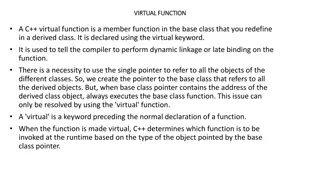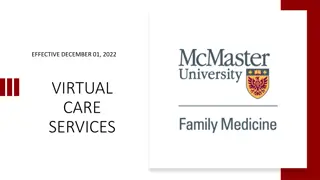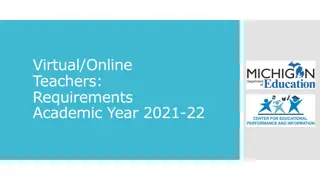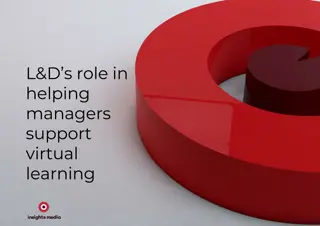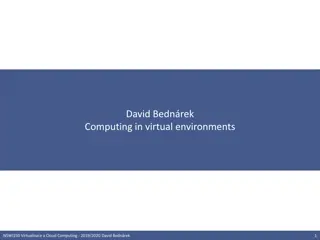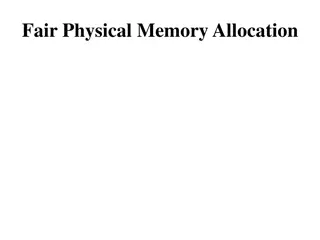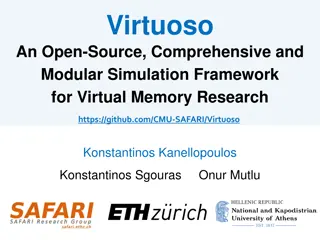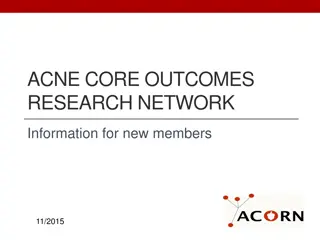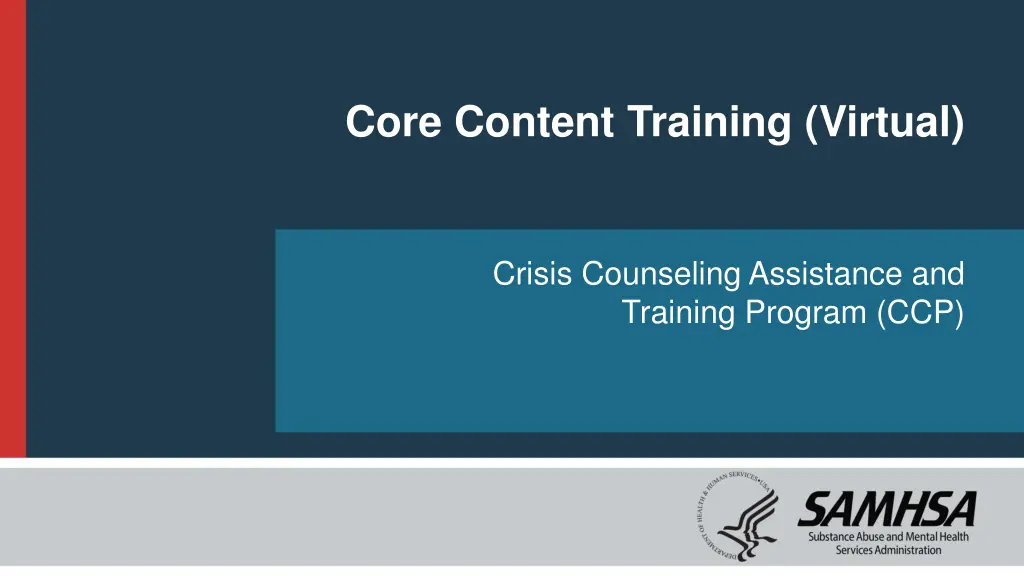
Crisis Counseling Assistance and Training Program (CCP)
Join our virtual training program to gain essential skills in crisis counseling during disasters. Learn about survivor reactions, stress management, data collection, and more to become a proficient disaster responder.
Download Presentation

Please find below an Image/Link to download the presentation.
The content on the website is provided AS IS for your information and personal use only. It may not be sold, licensed, or shared on other websites without obtaining consent from the author. If you encounter any issues during the download, it is possible that the publisher has removed the file from their server.
You are allowed to download the files provided on this website for personal or commercial use, subject to the condition that they are used lawfully. All files are the property of their respective owners.
The content on the website is provided AS IS for your information and personal use only. It may not be sold, licensed, or shared on other websites without obtaining consent from the author.
E N D
Presentation Transcript
Core Content Training (Virtual) Crisis Counseling Assistance and Training Program (CCP)
Technological Platform/Instructions Private message for tech support. Chat the entire group for questions/comments related to the training content. You will be assigned to breakout rooms during the training, and your participation is appreciated. If possible, participate in this training through your computer only (audio, video and microphone). If you call in by phone, please rename yourself with your full name instead of phone number so that we can better assign you to breakout sessions.
Poll Question #1 What is your previous experience with disasters? I am a disaster survivor I worked on a CCP previously I have been a Red Cross Disaster Mental Health Volunteer I have had disaster planning or response experience This is my first experience as a disaster responder Note: If you are not using the Zoom application, you will not have access to the poll questions. In that case, please type your answer in the chat box.
Poll Question #2 What is the main thing you want to get out of this training? Confidence to do my job Understanding what my job is Skills to help me do my job Key concepts backing up what we do Other (type it in the chat box) Note: If you are not using the Zoom application, you will not have access to the poll questions. In that case, please type your answer in the chat box.
Objectives After training, participants will be able to do the following: Describe the range of crisis counseling services. Identify typical disaster reactions. Demonstrate basic crisis counseling skills. Explain the importance of data collection and how to use it. Apply techniques for managing stress.
Course Agenda Day 1 Day 2 Welcome and Introductions Disaster Response Overview CCP and Services Survivor Reactions Special Populations Interventions and Skills Data Collection and Program Evaluation Stress Management Q&A, Applying Your Learning, Course Evaluation
Guidelines for Working Together Keep time (start on time, return from breaks on time, end on time). Switch mobile phones off or to vibrate. Turn off computer notifications. Mute yourself when you are not speaking so others can be heard clearly. Participate fully. Ask or submit questions freely. Balance talking and listening. Respect each other s points of view.
Section 1Disaster Response Overview Characteristics and Repercussions of a Disaster Federal Emergency Management Agency (FEMA) Disaster Assistance Disaster Response Structure and Operations
Characteristics and Repercussions of a Disaster Definition of a Disaster A disaster is a natural or human-caused occurrence (e.g., hurricane, tornado, flood, tsunami, earthquake, explosion, hazardous materials accident, mass criminal victimization incident, war, transportation accident, fire, terrorist attack, famine, epidemic) that causes human suffering. A disaster creates a collective need that overwhelms local resources and requires additional assistance.
Characteristics and Repercussions of a Disaster (cont.) Every disaster is different. Disasters affect individuals and the community. Response strategy depends on disaster characteristics. A disaster causes disruptions and changes.
Characteristics and Repercussions of a Disaster (cont.) Take 5 minutes on your own, and in your Participant Workbook, type or write responses to the following: What are the characteristics of this disaster (e.g., cause, size, scope)? Is this a natural disaster or a human-caused disaster? What has been the effect on survivors? Page 5 in your Participant Workbook
FEMA Disaster Assistance FEMA Disaster Operations Structure
FEMA Disaster Assistance (cont.) The Stafford Act establishes the following: All FEMA disaster relief services The intent of Congress The types of federal assistance programs Title 44 of the Code of Federal Regulations does the following: Carries out the intent of the Stafford Act Provides guidance to standardize the implementation of disaster programs The Stafford Act and Title 44 Code of Federal Regulations
FEMA Disaster Assistance (cont.) Types of assistance available from FEMA: Hazard Mitigation Public Assistance Individual Assistance (includes the FEMA CCP)
FEMA Disaster Assistance (cont.) Individual Assistance (IA) provides help for registered individuals, households, and businesses through the following: Temporary housing Loans Grants Unemployment assistance Crisis counseling Tax relief
FEMA Disaster Assistance (cont.) The Individuals and Households Program (IHP) provides registrants with the following: Financial assistance Direct assistance Housing
FEMA Disaster Assistance (cont.) The IHP also provides other assistance for registrants. The details of this assistance are as follows: Meets necessary expenses and serious needs Operates within pre-established grant limits Operates under national eligibility criteria Can provide funding for Personal property Transportation Medical, dental, and funeral costs Up to 3 years of flood insurance premiums IHP funding is 75 percent FEMA and 25 percent state/territory/tribal and may be administered by either FEMA or the state, territory, or tribe.
FEMA Disaster Assistance (cont.) U.S. Small Business Administration Loans Three types of loans exist: Home and personal property Business physical damage Business economic injury Loans are intended to return property to pre-disaster condition. Grants limit assistance to serious needs only. Loans have credit and flood insurance requirements and amount limitations.
FEMA Disaster Assistance (cont.) Disaster Unemployment Assistance (DUA) Offers benefits for up to 26 weeks Is available only if the individual has lost work due to the disaster Covers those not eligible for regular unemployment benefits Offers reemployment services Is funded by FEMA Is administered by the state, territory, or tribal employment security agency
FEMA Disaster Assistance (cont.) Other Assistance Disaster Legal Services (DLS) Provided by the Young Lawyers Division of the American Bar Association Offered free of charge to individuals who have insufficient resources Cora Brown Fund Provides for needs that will not be met by governmental agencies or other organizations
FEMA Disaster Assistance (cont.) Disaster Recovery Centers (DRCs) To receive FEMA resources, families need to register. Disaster survivors can register as individuals or heads of households. Local or regional centers provide information to disaster assistance registrants. DRCs may be staffed by mental health professionals.
FEMA Disaster Assistance (cont.) The National Processing Service Center 1 800 621 FEMA Serves as the central facility for gathering and reviewing eligibility for assistance Responds to disaster housing concerns of applicants Provides a toll-free helpline and online service to check the status of applications and obtain information about services: MA (1 800 621 3362) 1 800 462 7585 (TTY for individuals who are deaf or hard of hearing or who have speech disabilities) https://www.disasterassistance.gov
FEMA Disaster Assistance (cont.) Emergency Assistance Voluntary organizations active in disaster (VOADs) provide for immediate needs (food, shelter, and clothing). A FEMA voluntary agency liaison works to coordinate this relief.
FEMA Disaster Assistance (cont.) Crisis Counselor s Role Crisis counselors should be familiar with FEMA programs in order to inform and educate survivors and facilitate appropriate referrals. Survivors may have misconceptions about available assistance from FEMA. Crisis counselors should not join survivors in expressing angry reactions and should not take on the role of advocate for the survivor. The crisis counselor s role is to educate, inform, and support survivors in problem solving, prioritizing needs, and communicating their needs effectively, thus empowering survivors to advocate for themselves.
Disaster Response Structure and Operations Entities Eligible To Apply for and Receive CCP Funding States U.S. territories Federally recognized tribes and tribal organizations
Disaster Response Structure and Operations (cont.) The CCP consists of two grant types: Immediate Services Program (ISP): 60 days Regular Services Program (RSP): up to 9 months
Disaster Response Structure and Operations (cont.) Typical CCP Timeline
Disaster Response Structure and Operations (cont.) SAMHSA and FEMA Roles and Responsibilities Through an interagency agreement, SAMHSA works with FEMA to implement the CCP. SAMHSA and FEMA collaborate to Provide technical assistance and consultation Administer grants Oversee programs Ensure that grant services are in accordance with the CCP model
Disaster Response Structure and Operations (cont.) ISP Organizational Roles and Responsibilities Pages 10-11 in your Participant Workbook
SAMHSA Disaster Technical Assistance Center (DTAC) SAMHSA DTAC supports SAMHSA s efforts to prepare states, territories, tribes, and local entities to deliver effective mental health- and substance use-related responses during disasters. Toll-free: 1 800 308 3515 Email: dtac@samhsa.hhs.gov Web: https://www.samhsa.gov/dtac
5 Minute Break 1 Minute 2 Minutes 3 Minutes 4 Minutes 5 Minutes
Section 2CCP and Services Key Concepts Range of Crisis Counseling Services
Key Concepts The CCP model is Strengths-based Anonymous Outreach-oriented Culturally aware Conducted in nontraditional settings Designed to strengthen existing community support systems Based on an assumption of natural resilience and competence Page 12 in your Participant Workbook
Key Concepts (cont.) Outreach is Central to the CCP model Guided by initial and ongoing needs assessment A mechanism to find people in need A mode of service delivery
Key Concepts (cont.) Traditional Treatment Is office-based May involve diagnosis and treatment of mental illness, as well as identification of strengths and coping skills May focus on longer-term issues Validates experiences associated with distress that has brought the person to treatment Keeps records, charts, case files, etc. Crisis Counseling Is home- and community-based Involves identification of strengths and coping skills Counsels on disaster-related issues Validates common disaster reactions and experiences Does not collect identifying information
Range of Crisis Counseling Services Reach of Services Page 15 in your Participant Workbook
Range of Crisis Counseling Services (cont.) Population Exposure Model A. Injured survivors, bereaved family members B. Survivors with high levels of exposure to disaster, or evacuated from disaster zone C. Bereaved extended family and friends, first responders D. People who lost homes, jobs, or possessions; people with preexisting trauma; at-risk groups; disaster behavioral health responders E. Affected people from community at large Adapted from DeWolfe, D. (2002). Mental health interventions following major disasters: A guide for administrators, policy makers, planners, and providers. Rockville, MD: U.S. Department of Health and Human Services, SAMHSA, CMHS.
Range of Crisis Counseling Services (cont.) Breakout Activity: Needs Assessment Take 25 minutes to complete the following: Introduce yourselves to one another Begin with the person whose first letter of their first name is closest to the beginning of the alphabet Name, State/Territory/Tribe, Agency, and CCP role Discuss (from around page 16 in your Participant Workbook): The areas affected The special population groups The priority needs for the affected communities
5 Minute Break 1 Minute 2 Minutes 3 Minutes 4 Minutes 5 Minutes
Range of Crisis Counseling Services (cont.) Individual and family crisis counseling encounter video, https://youtu.be/jRPkSFhzM2U?t=181
Range of Crisis Counseling Services (cont.) Individual and Family Crisis Counseling Consists of encounters and visits with both adults and children Can include interactions with an entire family Can be brief, but is typically 15 minutes or longer Typically ranges from one to five visits The number of visits should be determined through discussions with supervisors and teams. Multiple visits may indicate a need for referral to longer-term services and should be discussed with supervisors. Page 19 in your Participant Workbook
Range of Crisis Counseling Services (cont.) Brief Educational or Supportive Contact Lasts less than 15 minutes Provides reassurance, other support, and information Page 19 in your Participant Workbook
Range of Crisis Counseling Services (cont.) Group crisis counseling and public education video, https://youtu.be/XrnGi8stDjg?t=160
Range of Crisis Counseling Services (cont.) Practical Concerns in Group Crisis Counseling Assess your own knowledge and skills related to the content of the group. Be aware of your own values, biases, and beliefs, and how these affect the group. Respect and maintain confidentiality. Facilitate do not dominate the conversation. Ask for feedback from the group. ASGW best practice guidelines. Journal for Specialists in Group Work,23, 237 244. Association for Specialists in Group Work (ASGW). (1998). Pages 20-22 in your Participant Workbook
Range of Crisis Counseling Services (cont.) Assessment and Referral Assessment is the process of reviewing, identifying, and evaluating survivors needs. The CCP screens for the following: Practical or tangible needs of survivors Substance use- and mental health-related needs Crisis counselors also identify resources in the community that match the needs of survivors. Resource linkage empowers survivors to advocate for themselves. Crisis counselors assist survivors in prioritizing and accessing services. Relationships with survivors are short-term. https://youtu.be/flei8krbcs0?t=235
Range of Crisis Counseling Services (cont.) Emergency Treatment Referral Alert the team leader if you notice any of the following: There is intent or means to harm self or others. A person exhibits severe paranoia, delusions, or hallucinations. Functioning is so poor that a person s (or dependent s) safety is in danger. Excessive substance use is placing a person or others at risk. A child s safety or health is at risk. When in doubt, call 911, or refer the person for immediate psychiatric or medical intervention. Page 23 in your Participant Workbook
Range of Crisis Counseling Services (cont.) Nonemergency Treatment Referral Reduce stigma: Demystify mental health or substance use treatment by explaining it. Explore referral options and give choices. Increase compliance: Explore obstacles to accepting services. Encourage the person to call for the appointment immediately or in the counselor s presence if possible. Page 24 in your Participant Workbook
Range of Crisis Counseling Services (cont.) Community Support and Networking Foster community resilience through improved connectivity. Promote familiarity with disaster relief resources. Create a seamless system for referral. Create opportunities for shared resources and training. Page 25 in your Participant Workbook


